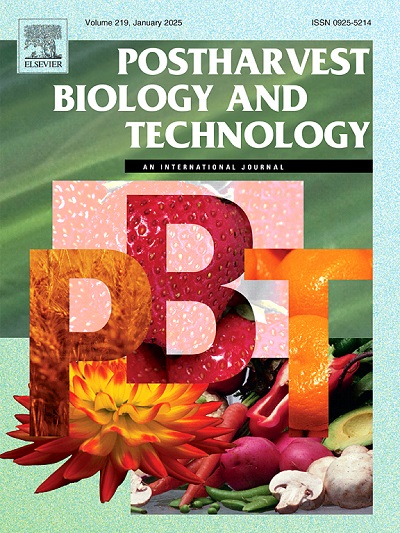Interaction of nitric oxide and extremely low oxygen storage on volatile organic compounds and overall quality of ‘Maxi Gala’ apples
IF 6.4
1区 农林科学
Q1 AGRONOMY
引用次数: 0
Abstract
This study aimed to evaluate the effect of nitric oxide (NO) application on overall quality and volatile compounds of ‘Maxi Gala’ apples stored under controlled atmosphere (CA) and with extremely low oxygen (ELO). The fruit were treated or not with NO at the beginning and end (10 + 10 µL L−1), or only at the end of storage (10 µL L−1) and, were stored under the following conditions: [1] CA (1.2 kPa O2; 1.6 kPa CO2) + 1-methylcyclopropene (CA + 1-MCP); [2] ELO (0.4 kPa O2; 1.6 kPa CO2); [3] ELO + 0.4 hysteresis; [4] ELO + 0.6 hysteresis and; [5] dynamic controlled atmosphere by respiratory quotient (DCA-RQ 1.3; 1.6 kPa CO2). After 7.5 months storage, plus 7 d shelf life, the fruit quality was evaluated. Fruit stored under ELO exhibited higher ACC oxidase activity, ethylene production, and respiration rate. ELO + 0.6 hysteresis maintained higher flesh firmness without NO application and suppressed total esters content similarly to CA + 1-MCP, but with less impact on 2-methylbutyl acetate. NO application at the beginning and end of storage resulted in higher concentrations of aldehydes, alcohols, and esters, but it reduced the concentration of phenolic compounds and flesh firmness, and increased the incidence of mealiness in CA + 1-MCP and DCA-RQ. NO applied only at the end of storage did not improve fruit quality. Thus, the reapplication of NO should be better evaluated under extremely low oxygen storage, although it can be a promising strategy to enhance the aromatic quality of fruit.
求助全文
约1分钟内获得全文
求助全文
来源期刊

Postharvest Biology and Technology
农林科学-农艺学
CiteScore
12.00
自引率
11.40%
发文量
309
审稿时长
38 days
期刊介绍:
The journal is devoted exclusively to the publication of original papers, review articles and frontiers articles on biological and technological postharvest research. This includes the areas of postharvest storage, treatments and underpinning mechanisms, quality evaluation, packaging, handling and distribution of fresh horticultural crops including fruit, vegetables, flowers and nuts, but excluding grains, seeds and forages.
Papers reporting novel insights from fundamental and interdisciplinary research will be particularly encouraged. These disciplines include systems biology, bioinformatics, entomology, plant physiology, plant pathology, (bio)chemistry, engineering, modelling, and technologies for nondestructive testing.
Manuscripts on fresh food crops that will be further processed after postharvest storage, or on food processes beyond refrigeration, packaging and minimal processing will not be considered.
 求助内容:
求助内容: 应助结果提醒方式:
应助结果提醒方式:


